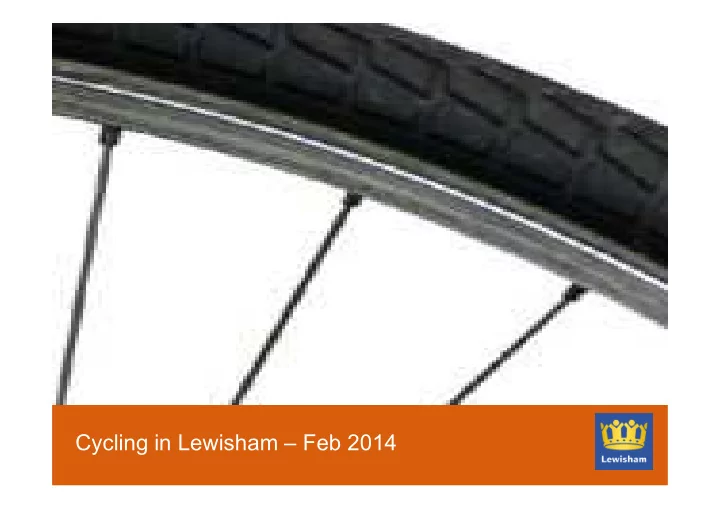

Cycling in Lewisham – Feb 2014
• The origins • The development • Transition • Current situation Cycling
• The first test was held for seven children on Oct 7 1947, as part of a pilot programme. • The National Cycling Proficiency Scheme was introduced by the Government in 1958 - way before the days of protective helmets and high- visibility jackets. National Cycling Proficiency Scheme
• In playground training, rolled out pretend roads • Training began to be moved on to the road but with signs and warnings that children were being trained = semi realistic NCPS
• Bikeability - 'cycling proficiency' for the 21st Century gives the skills and confidence to cycle in modern road conditions.
• Fit your own helmet • Carry out a simple bike check • Get on your bike, start cycling, then stop and get off • Ride your bike using the gears • Make your bike go where you want it to, including moving around objects safely around objects safely • Control the bike with one hand • Stop quickly if you need to • Look all around you when you’re riding, including behind, without wobbling Level 1
• Start and finish a journey by road, including passing parked or slower moving vehicles and side roads • Make a u-turn • Identify and react to hazards in the road • Signal your intentions to other road users when someone needs to know what you’re doing • Understand where to ride on the road • Use junctions, including turning left and right into major and minor roads • Decide whether a cycle lane will help your journey • Use the Highway Code, particularly when it comes to understanding road signs Level 2
• Make a trip to school, work or elsewhere on any roads • Use complex junctions and road features such as roundabouts, multi-lane roads and traffic lights • Understand driver blind spots • Know how (and when) to pass queuing traffic • Identify and react to hazardous road surfaces • Plan your route • Interpret road signs Level 3
Level 1 training
Level 2 Training Drink Drive Questions
• Bikeability isn’t only for children – Adults to take up the challenge too! For complete beginner, Boost your confidence Develop more advanced skills, Route Planning 1:1 lessons (500) 1:1 lessons (500) Group rides (50) Maintenance sessions (starting) Dr Bike (200) Cycle Loan scheme (500) Average year Lewisham interact with around 1500 cyclists a year Drink Drive Questions Skills for Adults
Education & Enforcement Days
• Exchanging Places Cyclists are given the opportunity to climb into the cab of a lorry and see what can and cannot be seen from the drivers seat. Resources = RSO’s, Police, Lorry Education & Enforcement Days
• Bike Loan scheme • £10 for 1 month • Try before you buy • 20% discount to buy • Lesson offered Bike loan scheme
• In 2013/14 - 500 people have registered their interest to borrow a bike. • Over 350 participants have gone through the scheme, with a further 70 on the waiting list. • Each participant is expected to complete a cycle diary throughout the loan period to monitor use of the bike, concerns or worries and how much cycling is being done. • The statistics offer some insight in to the schemes success but the real story can be seen at the drop off and collection days that run every other week at the Ladywell Arena sports facility. Loan scheme
• 46% of cyclists are using their loan bikes more than 3 – 5 times a week with 11% using the bike daily. • 60% of those using a loan bike are cycling more than they initially expected! • 66% said they feel safe when riding in Lewisham. • 89% are now looking to buy a bike, of which 45% • 89% are now looking to buy a bike, of which 45% buy a bike through the scheme, as in the bike they have borrowed for a month! • 30% of cyclists are using the bike for commuting, with a further 48% for fitness and leisure. Loan scheme
• Why is cycling good? • Regular cycling can help you lose weight, reduce stress and improve your fitness. • Cycling is one of the easiest ways to fit exercise into your daily routine because it's also a form of transport. It saves you money, gets you fit and is good for the environment. • For someone who weighs 80kg (12st 9lb) they will burn more than 650 calories with an hour's riding, and tone their legs and bottom. If you ride up hills or off-road, you'll also work your upper body. • Regular cycling can reduce the risk of chronic illnesses such as heart disease, type 2 diabetes and stroke. Thank you
• 20 mph speed limit • Encourage more cycling • Less car journeys to school • Encourage more walking • Encourage a greater feeling of safety For our vulnerable road users. • Safer roads throughout the whole of the borough – (on borough roads)
Liz Brooker Road Safety and Sustainable Transport Manager LB Lewisham +44 208 314 2254 liz.brooker@lewisham.gov.uk Thank you
Recommend
More recommend